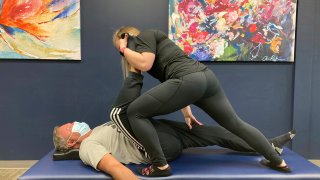
Pandemic-weary Americans starved for human interaction and physical touch are taking advantage of a growing wellness option once reserved for Hollywood actors, rock stars and elite athletes: boutique stretching.
“It’s like a workout, but you feel way more flexible," a masked Kelly O'Neal, 51, said as her leg was being pulled across her body during a recent session at a newly opened StretchLab studio in Centerville. "I get plenty done after I get done here because you just feel like you’ve warmed up really well.” She said her legs and feet ache after her shift at a grocery store in southwest Ohio — often plus overtime because of COVID-19 demands.
Others cite some intangibles offered by assisted stretching during the coronavirus.
“It’s really nice to be touched. It is,” said Laura Collins, 39, who visits a StretchLab near her home in White Plains, New York, twice a week. “We’re being deprived of social interaction, we’re being deprived of hugs and people who are familiar, and ... it’s just so comfortable being there.”
We've got the news you need to know to start your day. Sign up for the First & 4Most morning newsletter — delivered to your inbox daily. Sign up here.
Even before the pandemic, assisted stretching studios — with names such as Stretch Zone, Stretch Pro, LYMBR and Stretch*d — often featured just eight or 10 widely spaced tables in a shared area they say is conducive to good air circulation.
Kory Floyd, a professor of communication and psychology at the University of Arizona, said activities that provide social interaction and some relief for “skin hunger” can help people manage stress better. A lack of casual touch — holding hands, hugging, putting one’s arm around somebody, shaking hands — can have a significant negative impact, Floyd said.
Touch, he said, “is beneficial even when we don’t have a solid, strong emotional connection to the other person" — which can be the case with assisted stretching. "We may not even know the other person, and yet we can still benefit in part from just the attention and the sense of connection that we have, but also from the touch itself.”
Health
Loren Anthes, who follows the healthcare industry as a researcher at the Cleveland-based Center for Community Solutions, said stretch studios appear to be using a franchise model to offer lower prices for services resembling physical therapy and massage but delivered without the overhead and certifications required of skilled nursing facilities or hospitals.
He said the concept sounds like a hybrid between recreational fitness and insurance-covered wellness services.
“The essential question we have to ask ourselves related to any of these organizations that spring up is are they causing folks harm,” he said. “And as long as they’re not, or purporting themselves to be licensed medical professionals, then I don’t see much of a distinction between what they’re doing and offering a gym membership or a Pilates class or anything like that.”
Desperation for physical touch and socialization during COVID-19 lockdowns came just as the stretching industry was already transitioning from an elite service centered in places like New York, Miami and Los Angeles to a retail model, said Vanessa Chu, who co-founded Stretch'd in New York City three years ago.
“Our goal has always been to make it highly accessible to people — accessible from a price standpoint, from a location standpoint,” Chu said. That includes taking some activities and training online.
Another business, Stretch Society, with two locations in Georgia, has added one-on-one stretching to its Stick Stretch classes and other offerings, according to its website.
Beth McGroarty, vice president for research at the non-profit Global Wellness Institute, said growing interest in stretch coincides with a new focus in the fitness world on recovery rather than just activity.
“Stretch was definitely a trend going into COVID and probably got ramped up because of it,” she said, noting that ClassPass found that stretch classes were among the most popular online during COVID. “I mean it's ancient, a lot of this stuff. It's just getting an update.”
Every company is a little different, but the technique generally involves a trained practitioner elongating a client’s muscles to somewhere past where they could get them on their own, and the client offering resistance for a period of time.
Sessions in Centerville range from $49 for a 25-minute stretch to $95 for a 50-minute stretch. Four-, eight- and 12-month packages are also available, as are family plans and group stretches.
No accreditation is yet available for stretch technicians. Stretch companies typically require a certification and experience in another bodywork field, plus additional training in their particular method.
Janna Proctor, who owns the franchise in Centerville, said the studio's recent opening attracted practitioners hurt by the economic impacts of virus restrictions.
“We had 40, 50 qualified candidates apply,” she said. “Because PTAs (physical therapy assistants), personal trainers, massage therapists, all the backgrounds we were looking for — that prior knowledge — they were all out of work."
Nationally, 1.4 million fitness industry employees lost jobs as a result of the coronavirus pandemic as of Dec. 31, according to statistics from the International Health, Racquet & Sportsclub Association. Amid revenue losses of over $20.4 billion industrywide, more than 17% of health clubs, gyms and studios have permanently closed.
Chu said Stretch'd is training hundreds of people around the country through courses that moved online during the coronavirus.
“It's going to be coming to a lot of different markets now,” she said.



